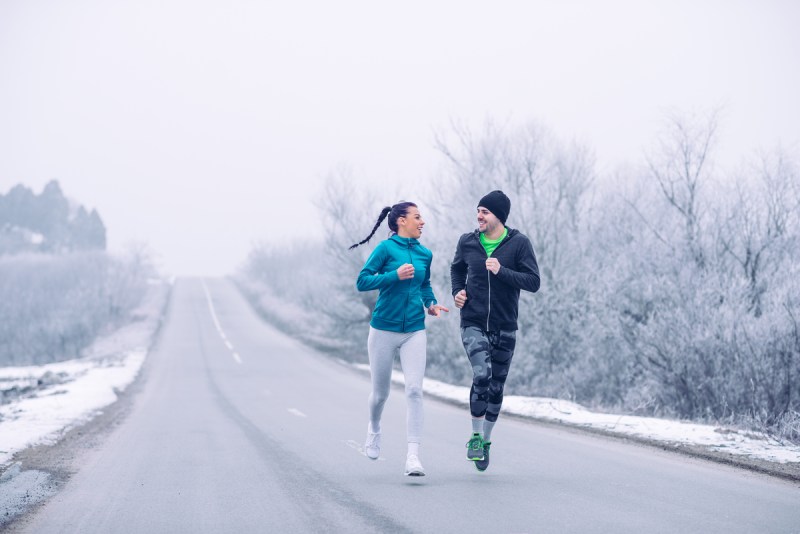When the season turns cold, most people decide to take their workout routines inside, but being outdoors while in winter can do amazing things for your mood during some of the darkest days of the year. One major issue that some people face while participating in outdoor winter activities is muscle cramps. Here’s everything you need to know about banishing and preventing muscle cramps while out on your biggest winter adventures this season.
Why cold weather causes cramps

If you’ve ever experienced a muscle cramp from the cold, you know how much of a toll the winter can take on your body. Muscle cramps in cold weather can occur for a few reasons. As temperatures drop, the cold temperatures will cause your blood vessels to constrict to conserve heat. They tend to tighten up and contract, which causes them to receive less oxygen and nutrients. Think about how much that’s multiplied when you add the physical exertion that a lot of winter sports require. Your muscles will have to work so much harder under cold conditions, which makes them more prone to fatigue.
Once you reach this state, your muscles can be sore for long periods of time. While you can’t change the weather, there are, fortunately, several practices you can adopt to ensure your body is protected and ready to perform all winter long.
Here’s how to banish cramps caused by cold weather

1. Warm up thoroughly
One of the top tips for preventing muscle cramps and soreness during the winter months is properly warming up. During warm or even hot months when muscles are already more limber, it can be tempting or even regular practice for some people to skip their warm-up. However, during cold weather, there is a much greater need to give your body the time it needs to get warm before demanding high-performance tasks or movements from it.
To warm up the muscles and get the blood pumping, there are a number of exercises you can do. Walking at a brisk pace is a good option as is slow, careful jogging. Stretching and aerobic movements such as easy punching or kicks are also good options.
So how long should you be warming up? Make sure you spend enough time on your warm-up. Temperatures between 35 and 45 degrees Fahrenheit require at least a 10-minute warm-up. For temperatures below 35 degrees, plan on adding an additional five minutes to your warm-up for every 10-degree decrease in temperature. That means a 15-minute warm-up is required for 25-degree conditions.
2. Hydrate appropriately
Staying hydrated during physical activity is always important. But staying hydrated during cold-weather exercise and activity is even more crucial — especially for preventing muscle cramps and pains. Dehydration is a major cause of muscle cramps, so even if it is cold, you do need to make sure you get plenty of water to drink before, during, and after outdoor winter exercise.
Avoid relying on diuretics such as coffee and hot tea that actively dehydrate, and stick with regular water. If you really despise drinking cold or room-temperature water during winter, you can always heat it up. Alternatively, consider an electrolyte drink.
Adding electrolytes to your hydration is a great way to fend off an imbalance. Sodium, potassium, and magnesium are all extremely important for proper muscle contraction and relaxation. If you’re planning on a hiking trip, you’ll be sweating out these crucial vitamins, which can lead to erratic muscle contractions and cramps.
3. Consider adding heat
Finally, adding heat packs or hand warmers to your layers before heading out is another great way to keep your muscles warm. However, this isn’t a means for skipping or avoiding a warm-up. When applied to your body, heat helps boost blood flow and ease the tension of sore or tight muscles. That will not only help existing tendencies for muscle cramps but will also help prevent more from occurring.
If wearing a thermal pad isn’t an option, then consider adding a hot soak with Epsom salts to your evening routine. The salts and hot water will help alleviate any pains or stiffness you might have from working or exercising in the cold.
Overall, stay safe

When hiking in cold weather, overexertion, nerve irritation, and fatigue are common risks that can compromise your safety and lead to cramps. Make sure you invest in high-quality, weather-appropriate gear before you go out, like boots, gloves, hats, snow pants, and jackets.
Plan for a route that matches your energy and fitness levels, taking into account that you won’t be as flexible or light as you would be in the summer. Heavy winter boots and snowshoes can feel like 10-pound weights by the third mile, so if you’re feeling overwhelmed, it’s OK to cut your hike short.
Safety should always be your number one priority. Plan shorter hikes, take breaks along the way, and hike with a partner who can help monitor your condition.



